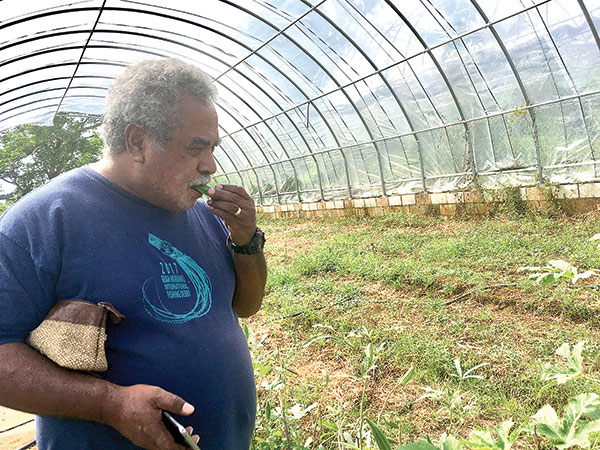Making agriculture productive in a time of climate change

Division of Agriculture director Jack Ogumoro eats a freshly picked okra in the high tunnel farm at the CNMI Division of Agriculture office in Kagman. (IVA MAURIN)
One U.S. farm feeds 166 people annually in the U.S. and abroad, according to the American Farm Bureau Federation. With global population expected to increase to 2.2 billion by 2050, the world’s farmers would have to grow about 70% more food than what is now being produced.
Yet farmers also have to contend with the impacts of climate change, such as reduced arable lands, floods, wildfires, and reduced availability of freshwater.
That would require finding ways to adapt to a changing environment, especially among islanders, who are already faced with limited available land areas, according to Division of Agriculture director Jack Ogumoro.
“There is just so many things that are happening as a result of climate change, and some, if not most, will directly impact us,” Ogumoro said. “The best we can do is to find ways to adapt to our environment.”
One of these adaptation methods is the use of high tunnels in farming.
High tunnels are structures, usually covered with a layer of plastic and use solar heat, that are used by farmers to extend their crops’ growing season.
“The high tunnel is just another tool to allow farmers to plant crops that are seasonal,” Ogumoro said. “As a result, the plants, which are seasonal and grow at only certain time of the year, can be grown [for a] longer [period]. They can extend their [production period], they can survive, they can continue to produce and that’s because of the tunnel.”
For instance, with the high tunnel, if a farmer has a crop that only grows during the dry season, that plant can continue to grow even when the rainy season comes. The time the plant can continue to produce gets extended.
Right now, the Division of Agriculture has seven high tunnels, two of which have yet to be handed over to Rota and Tinian. The DA team is planning to go to both islands next month to set up the high tunnels.
The high tunnels are funded through the Specialty Crop Block Grant Program, a federal program under the Agricultural Marketing Services within the U.S. Department of Agriculture.
“It is our obligation to ensure that we reduce [activities] that contribute to climate change,” Ogumoro said. “We are now experiencing the frequency of typhoons here as a result of climate change. Folks in other parts of the world have been using this [high tunnel]. We are trying them out to experiment whether this is a good solution for our community here in the CNMI.”























